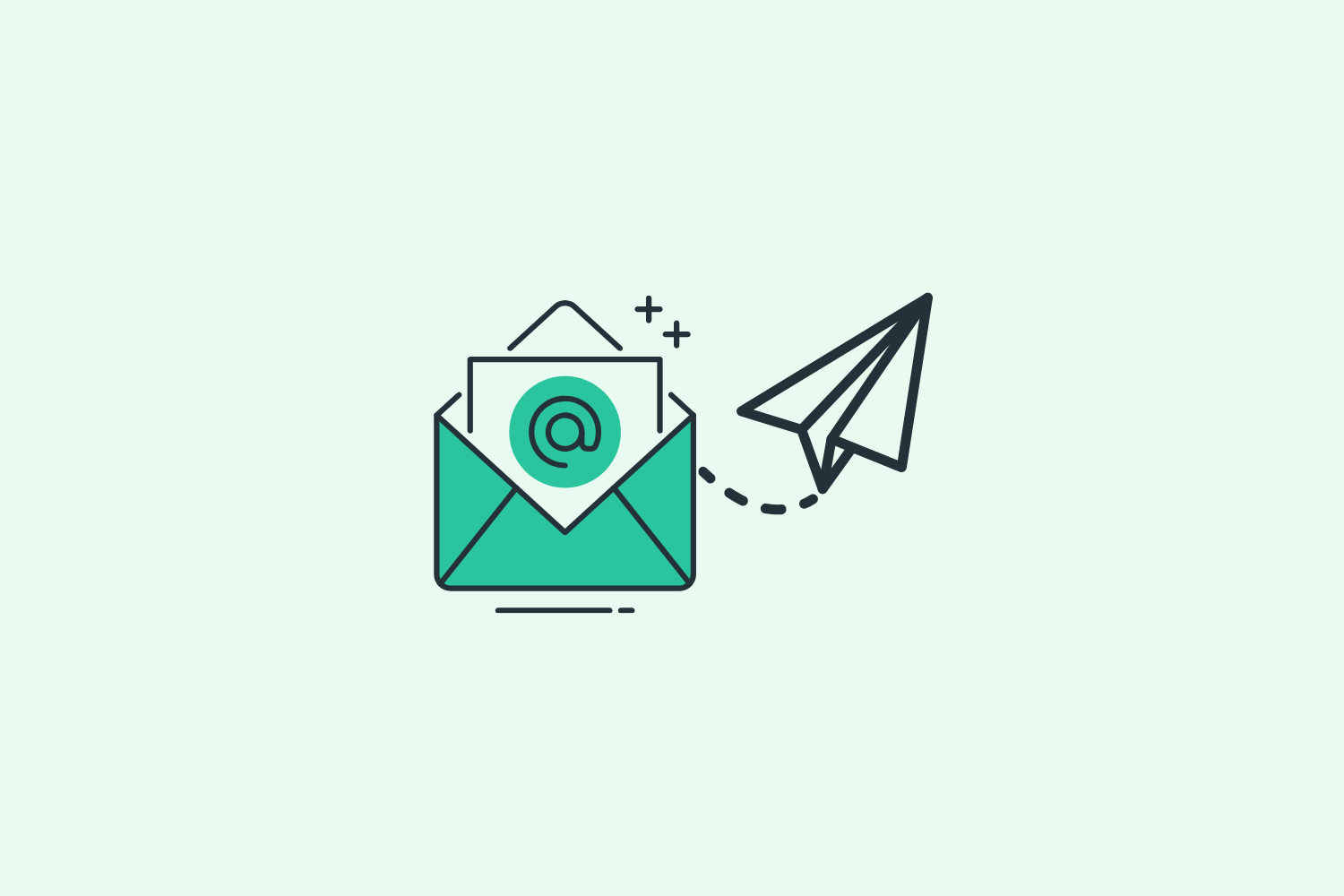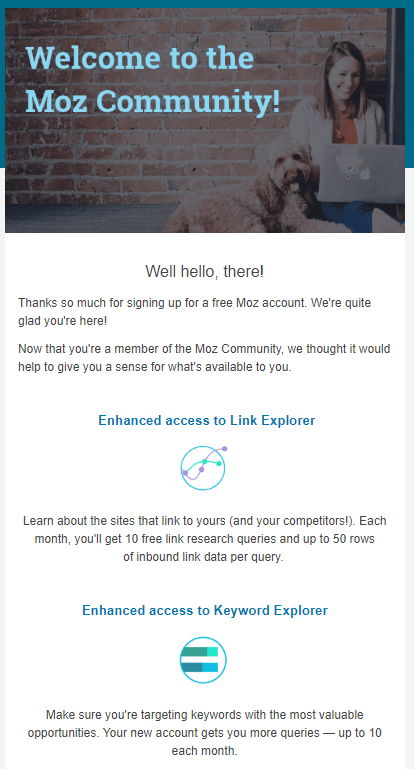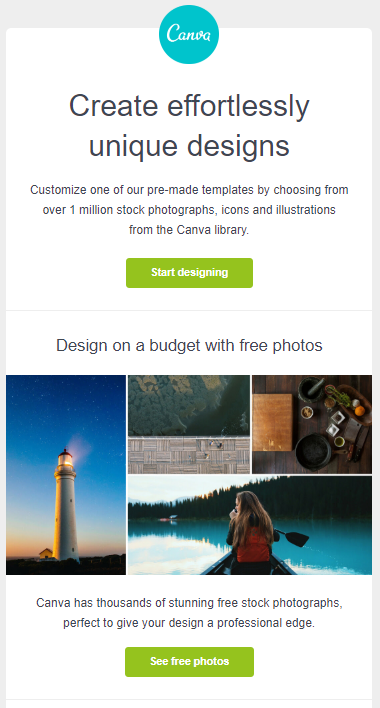Table of Contents

Be honest: are your onboarding emails actually getting users excited about your product?
The onboarding process is obviously make-or-break if you’re in SaaS. Either your sign-ups stick around for the long haul or those could-be users disappear into the abyss.
Meanwhile, it’s oft-cited that ~50% of SaaS users will log into an account and never return. Couple that with a ~21% open rate for software emails as of 2020, and it’s clear than sign-ups are anything but a sure thing.
But hey, it’s not all gloom and doom.
Granted you’re putting together messages that actively engage those sign-ups to take action.
In this guide, we’ll hook you up with some onboarding email templates to do exactly that.
9 onboarding email templates that pull users into your product
Below we’ve put together nine onboarding emails that are fair game for any SaaS company.
Of course, you’ll need to tweak and adapt these according to your brand voice, product and so on.
Also, you might consider swapping out or duplicating these templates based on how long your onboarding series is (think: a week versus 10 days or two weeks).
1. The welcome email
Your onboarding welcome emails are arguably the most important in your series.
After all, you’re tasked with making a meaningful first impression on your new sign-ups. You obviously want to hook them here and score that ever-so-important initial login.
Your end-game? Get your product in their hands ASAP.
Subject: Welcome to {app name}! / Let’s get started with {app name} / {app name} welcomes you / {customer name}!
Hey {user name},
Thank you for signing up for {app name} and welcome to the community!
We’re stoked to see what you’re able to {action (create, do, etc)} with our {app, tool, service}.
To get started, we recommend checking out our {quick-start guide} that’ll walk you through the basics of {app name} step-by-step. We also have a {two-minute intro video} if you’re more of a movie buff.
And if you’re ready to start {action (creating, exploring, etc)}, you can log in below!
{CTA button}
Cheers!
{signature}
Here’s a solid welcome example from Moz, doing double duty of inviting new users into their community while also highlighting some of the tools’ top features.

2. The pro-tip
Sometimes sign-ups need a bit of nudge to get started with a new SaaS tool.
Maybe they’re initially overwhelmed by your interface. Perhaps they remember signing up but need a quick refresher as to why they need your service.
And hey, you never know. There are tons of reasons why someone might have slept on your welcome message (lost among Amazon shipping notifications, deleted by accident, weird time zones, etc).
Your goal here is to highlight basic features and suggested steps to get a taste of what your software is capable of.
Subject: How to start {benefit (saving, earning, driving traffic, etc)} with {app name} / Your account is active! Now what? / Tips for taking the next step with {app name}
Hey {user name},
Need a bit of help getting started with {app name}?
Hey, we get it: there’s so much you can do!
Here are a few suggestions to get better acquainted with us (and start {seeing benefit}):
-
{Action/feature #1, optional link and/or corresponding resource to help}
-
{Action/feature #2, optional link and/or corresponding resource to help}
-
{Action/feature #3, optional link and/or corresponding resource to help}
If you have any questions in the meantime, feel free to reach out to us at {contact}.
Cheers!
{signature}
This message from Canva highlights multiple points for users to land based on what’s relevant to their interests. Allowing users to explore specific features makes the product more actionable versus directing them to a general login page.

3. The case study suggestion
Food for thought: case studies are among the most effective types of content for B2B buyers.
Bringing up customers and case studies is a brilliant way to invite your sign-ups to feel like they’re part of a community. Highlighting use cases also makes your product seem much more actionable.
And if nothing else, these types of messages are prime for attention-grabbing subject lines that include striking stats and numbers.
Subject: How a {app name} user saved {# of} {pain point, time, money} / Could you use an extra {# of} {time, money (based on case study)}, {customer name}? / Are you our next community success story?
Hey {user name},
We love it when our customers win.
If you’re looking for inspiration on how to use {app name}, you should totally check out {case study company/user}’s story.
They managed to {save # of hours, generate # of revenue, drive # traffic/followers, etc} using our {app, service, tool}.
You can {watch/read} their story below:
{CTA button}
Hopefully, you‘ve been rocking it with {app name} so far.
And who knows, maybe you’ll be our next success story. Here’s to hoping!
Cheers!
{signature}
This onboarding email example from Sleeknote is personable and points readers to a blog post which breaks down a variety of product use cases and testimonials.
Messages like this are a double win. They drive traffic to your blog while also introducing new users to powerful examples of social proof.

be honest
How well do you know your business?
Get deep insights into MRR, churn, LTV and more to grow your business
4. The most important feature
Ask yourself: if there’s a single feature you’d want your new sign-ups to check out, what would it be?
What’s going to keep them glued to your product versus that of your competitors?
Important features are good to emphasize in onboarding emails, especially if they’re time-sensitive and expire prior to an upgrade. These types of messages are hype-worthy, allowing you to get creative with your subject line(s).
Subject: 99% of our users can’t live without this / How {app name} users save {pain point} / Are you sleeping on {your industry}’s secret weapon?
Hey there, {user name}
We just wanted to check in to make sure you’re not missing out on {app name}’s most powerful feature.
{Description of notable feature, highlight benefit(s) and/or use cases}
You can get started with {feature} by {logging in below, checking out this tutorial/video}. Our community swears by it and we think you’ll dig it, too.
{CTA button}
Cheers!
{signature}
Below is Salesforce’s onboarding invitation to check out how the platform’s Opportunities work. Given that Salesforce is so massive, honing in on a single feature is a good move to keep new users from getting overwhelmed.

5. The personal touch
Note that many SaaS company emails are presented on behalf of employees rather than companies themselves.

That’s not just a stylistic choice.
Fact: “personal correspondence” (#1) and “content that was made just for me” (#6) are among the top reasons people engage with emails according to data from Campaign Monitor.
This is an opportunity to switch up your tone a bit by getting personal. Here you can present yourself purely as a helping hand rather than a company presenting a sales pitch.
Subject: How are you digging {app name} so far? / Quick question for {customer name}! / A personal shoutout from us at {app name} / Any questions for me?
Hey there, {user name},
This is {name} from {app name}. I just wanted to personally thank you for using {app} and joining our community. We’re glad to have you!
If you have any questions about your trial so far, I’d be more than happy to answer them.
Oh, and I also wanted to give you a quick heads up on a couple of my favorite features of {app} that you might not have checked out yet:
-
{Action/feature #1, highlight benefits and link to relevant resources}
-
{Action/feature #1, highlight benefits and link to relevant resources}
Don’t hesitate to reach out if you need any help!
Have a good one!
{signature}
This onboarding email from Ryte indeed feels like it was written by an employee (note the signature, emoji and simple sentences), representing a welcome break from more traditional onboarding emails.

6. The helping hand
No surprises here.
At this point, you’re trying to make sure that your sign-ups have everything they need to be successful, long-term customers.
This message can be sent on the tail-end of a trial for non-responders or as part of your general onboarding emails as a catch-all for questions. (check out this article for free trial email templates!)
Subject: Do you need any help? / How can I help? / Need a hand using {app name}
Hey {user name},
I just wanted to check in to see how things were going with your {app name} trial.
Chances are you’re crazy busy and I totally get it. We just love to hear from our community when it comes to favorite features and how you’re using {app name}.
Remember: you can always get in touch with us at {contact}. There’s also our {community hub} and {quick start guide/video} for instant answers.
Thanks,
{signature}
Another one from Sleeknote, this check-in is a sort of positive “reset button” for someone who’s slept on their solution. The tactic of asking readers to remember why they got started in the first place is a nice touch.

7. The upcoming expiration
Tick-tock, tick-tock.
Now’s the time to crank up the sense of urgency and encourage sign-ups to make sure that they understand that your time together is almost up (unless they subscribe).
Subject: The clock is running down!
/ Your {app name} trial is expiring soon / Don’t say goodbye to your account!
Hey {user name},
Can you believe that your {app} trial is almost coming to an end?
We know. Time flies.
We not only want to take a moment to thank you for being part of our community but also see if there was anything we could do to help {address pain point}.
And if you’re interested in potentially extending your trial or upgrading your account, let us know below.
{CTA button}
Thanks
{signature}
This onboarding email from BuzzSumo both highlights key features prior to the trial’s end and provides an opportunity for personal outreach for users who are interested.

8. The no-responder
Here it is: the last-ditch effort. These messages are for folks who maybe read a few of your onboarding emails but never engaged properly.
This is your opportunity to thank them for their time and leave the door open to do business together down the road.
Subject: We hate to see you go… / I guess this is goodbye (for now) / Our door is always open, {customer name}
Hi {user name},
All good things come to an end, right? And so it goes for your {app name} trial.
No worries, though. We sincerely hope you found our {app, tool} useful. If you do decide to come back, everything in your account is saved and ready for you.
If you have any more questions about your account or want to give {app} another go, feel free to {contact us} or {check out our plans/pricing tiers}.
We hope to hear from you again!
{signature}
This AWeber onboarding email is solid, making it clear that despite the trial’s end the door’s open for users to return.
Including a personal picture and P.S. is a positive, personal touch that leaves a good impression on the reader.

9. The add-on
Let’s say you’ve won a subscriber (congrats!) and rightfully want to keep the momentum going.
After your new subscriber has had an opportunity to give your product a proper spin, consider letting them in on an upgrade or add-on offer.
Doing so early on in their customer lifecycle can ultimately help them see the full scope of your product and its benefits, priming them to become a long-term subscriber.
The key here is to hammer home the benefits of the upgrade rather than get too in the weeds about specific features.
Subject: Ready to see {app name} at full strength? / It’s time to level up!
Hey there {user name},
Hope you’ve been enjoying everything that {app name} has to offer!
Speaking of which, we wanted to give you a quick heads up on some premium features included in our {upgrade name} plan.
-
{Benefit (ex: get even more done)}.
-
{Benefit (ex: dig deeper into your data)}.
-
{Benefit (ex: share more with your team)}.
Here’s a quick sneak peak of our leveled-up product in action:
{Screenshot, .GIF}
If you’re interested in upgrading or want to see how our premium users are taking advantage of {add on}, check it out:
{CTA button}
Either way, let us know if you have any questions and thanks for being part of our community.
Cheers!
{signature}
This onboarding email from Wave.video gets straight to the point inviting users to upgrade, showing off a variety of features via images and .GIFs to pique the reader’s interest.

Bonus: best practices for writing your onboarding emails (+ examples)
Crafting a positive onboarding experience is among the most important customer retention strategies.
And so understanding the anatomy of top-performing onboarding emails is a plus for SaaS marketers.
To wrap things up, we’ll quickly review some best practices of onboarding emails (and why they’re worth sticking to).
Keep your messages on the shorter side
You probably noticed that most of our onboarding templates were pretty short and to-the-point, right?
Sure, there’s plenty of debate over the “ideal” length of a business email (although recent research seems to point the 50 to the 125-word range as the sweet spot).
Rather than obsess over word count, consider the purpose of your onboarding emails in the first place. You don’t need to provide in-depth tutorials or instructions for your sign-ups. All of that happens after they click through your call-to-action.
Feel free to go into more detail, but bear in mind that you can get the job done with just a sentence or two (see the example below from Otter.ai).

Make your onboarding emails people-centric
This might seem like a no-brainer, but anything you can do to make your onboarding emails feel a bit less robotic is huge.
Chances are your sign-ups have been through the song and dance of an onboarding series before. They know the messages are on autopilot. That doesn’t mean they have to be boring or devoid of any sort of personality, though.
Beyond having a distinct voice, some other strategies to make your messages seem more human include:
-
Showcasing actual employees or customer photos
-
Highlighting social proof and positive feedback from your customers
-
Sending some of your onboarding emails from an employee account (as noted earlier)

Avoid generic subject lines to prevent getting lost in the clutter
If you’re not agonizing over your onboarding emails’ subject lines, you probably should be.
It’s well-documented that nearly half of consumers read emails based on the subject lines alone. They’re the barrier-to-entry that determines whether or not your email gets opened, let alone clicked-through.
Although generic subject lines (“Step #2: How to use _____”) aren’t necessarily awful, they’re not exactly exciting. On the flip side, here are some actual subject lines of SaaS onboarding emails that pique your interest and make you want to learn more:
-
“You’re in! What do you want to organize?” (from CoSchedule)
-
“Now that you’ve gone PRO…” (Flock)
-
“You’re not getting the Fullstory yet” (Fullstory)
-
“Supercharge your workflow” (Marvel App)
-
“Does your team spend 80% of their time doing this?” (Twist)
See how that works?
Don’t let your visuals get in the way of your message
Imagery including your call-to-action buttons and graphics are obviously important to your onboarding emails.
That said, they shouldn’t distract from the meat of your message.
How so?
For example, consider how making emails too “busy” with tons of images, buttons, and links could ultimately overwhelm your reader. Onboarding emails are typically about taking sequential steps, not dumping a bunch of links and graphics and hoping they click on something by sheer luck.
Again, many SaaS emails are minimalist. Straight and to the point. This style makes it difficult to miss key information and your subsequent CTA.

Here’s another example from Airtable, for reference:

And with that, we wrap up our guide!
Are your onboarding emails actually reeling users in?
There are plenty of moving pieces to your onboarding series. That said, These templates and tips are a solid starting point for any SaaS company.
By writing engaging messages that actually draw readers to take action, you’ll be poised for long-term customers rather than sign-ups that bounce.
All the data your startup needs
Get deep insights into your company’s MRR, churn and other vital metrics for your SaaS business.
{{cta('132180296632')}}


